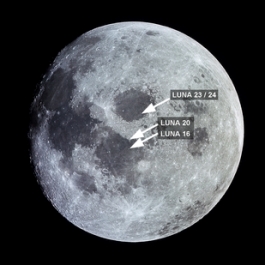Mar 26 2010
ASU and Johns Hopkins University researchers have located the spacecraft from Soviet Union lunar sample return missions with Lunar Reconnaissance Orbiter Camera (LROC) images.
 Apollo 11 image (AS11-44-6667) centered on the region of the eastern limb of the Moon (as viewed from Earth). Mare Crisium is the circlular mare in the center where Luna 23 and 24 landed. Luna 16 landed in Mare Fecunditatis to the south and Luna 20 landed in the highlands between Mare Crisum and Mare Fecunditatis
Apollo 11 image (AS11-44-6667) centered on the region of the eastern limb of the Moon (as viewed from Earth). Mare Crisium is the circlular mare in the center where Luna 23 and 24 landed. Luna 16 landed in Mare Fecunditatis to the south and Luna 20 landed in the highlands between Mare Crisum and Mare Fecunditatis
The descent stages of three successful Soviet sample return missions (Luna 16, Luna 20 and Luna 24) and the complete spacecraft of one of the unsuccessful missions were located (Luna 23). Due to limited tracking capabilities at the time of the missions, the exact positions of landing sites were known to only a few kilometers; the new data currently allow a location accuracy of about 100 m (328 ft). Knowing the exact locations provides scientists studying the returned samples confidence in their interpretations because the geologic context of the samples is now understood.
“Despite the small size (a few pixels) of the robotic spacecraft, finding them was fairly easy as their retrorockets blew away the very fine particles of the uppermost regolith," said Mark Robinson, professor in the School of Earth and Space Exploration in ASU’s College of Liberal Arts and Sciences. "This disturbance resulted in an inner dark patch under the lander and a brighter surrounding region, together about 20 meters to 30 meters (60 feet to 100 feet) across when viewed under noontime illumination.”
“LROC Science Team members carefully analyzed all the images as they came down and guided the targeting team until all the spacecraft had been found," Robinson said. "In some cases several images were needed. The whole search has been a lot of fun!”
Luna 16 was the first robotic mission to land on the Moon and return a sample to the Earth. It was launched by the Soviet Union Sept. 12, 1970; landed on the Moon Sept. 20; lifted off Sept. 21; and returned to the Earth Sept. 24. The lunar landing occurred on the basaltic plains of Mare Fecunditatis, and about 101 grams (3.5 ounces) of lunar material were returned. Sampling operations were conducted entirely in the dark since the Sun had already set when Luna 16 touched down.
Luna 20 landed in the lunar highlands about 120 kilometers (75 miles) north of Luna 16 and was the second successful Soviet sample return. Luna 20 was launched Feb. 14, 1972; landed Feb. 21; launched the sample back to the Earth Feb. 22; and the sample reached the Earth on Feb. 25. The landing site was on one of many rolling hills in the lunar highlands. About 55 grams (1.9 ounces) of material was returned.
Luna 24 was sent to Mare Crisium, on the eastern limb as seen from the Earth, where Luna 23 unsuccessfully attempted a sample return almost two years earlier. Luna 24 was launched Aug. 9, 1976; landed Aug. 18; launched back to Earth Aug. 19; and returned to Earth Aug. 22. Luna 24 returned 170 grams (6 ounces) of lunar basaltic regolith (soil) and was the last Soviet mission to the Moon and the last mission to soft land on the lunar surface (Apollo 17 left the Moon in December 1972).
A puzzling aspect of the Luna 24 samples was that they were not what had been anticipated from remote observations. It turns out that Luna 24 landed on the outer rim of a 64 meter (210 feet) crater and it sampled the ejecta from that crater, which may represent a subsurface unit with a composition differing from the typical surface of Mare Crisium.
Luna 23 had been sent to Mare Crisium in October 1974. Although the spacecraft landed and communicated with the Earth, it was unable to retrieve a sample. The landing occurred on a relatively featureless part of the mare surface and the entire spacecraft still sits on the lunar surface. Luna 24 landed about 2.4 kilometers (1.5 miles) from Luna 23.